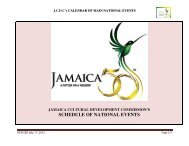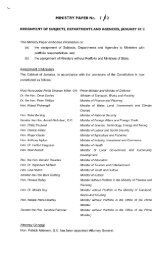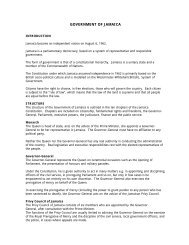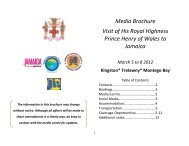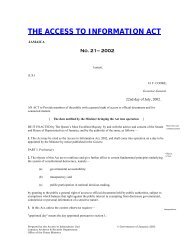Recommendations For The Restructuring Of - Jamaica Information ...
Recommendations For The Restructuring Of - Jamaica Information ...
Recommendations For The Restructuring Of - Jamaica Information ...
Create successful ePaper yourself
Turn your PDF publications into a flip-book with our unique Google optimized e-Paper software.
Public infrastructure and related services<br />
Efficient public bureaucracy<br />
An appropriate policy environment and regulatory mechanisms and<br />
Effective diplomacy.<br />
<strong>The</strong> determination of the core functions of Government was informed by an understanding of<br />
“what Government should do and pay for; what government must pay for, but does not have to<br />
do; and what Government should not do and should not pay for” (Osborne and Plastrik, 1997) 1 .<br />
Importantly, the rationalisation was guided by the imperative for a <strong>Jamaica</strong>n Public Sector that<br />
is service oriented, results-based and guided by appropriate accountability mechanisms and<br />
which therefore provides an enabling environment for the achievement of the Vision 2030:<br />
“<strong>Jamaica</strong> the place of choice to live, work, raise families and do business”.<br />
<strong>The</strong> Approach<br />
<strong>The</strong> approach adopted in the exercise was iterative and inclusive involving major stakeholders<br />
within the Public Sector and Trade Unions. Permanent Secretaries were asked to review the<br />
functions of their specific Ministry, Departments and Agencies and decide upon one of six<br />
options namely: retention, transfer, merger, abolition, divestment/privatisation and contracting<br />
out. Matrices were completed, reflecting the recommendations posited by the Permanent<br />
Secretaries and signed off by the respective Ministers. On review of the matrices and in<br />
consultation with all Permanent Secretaries, additional modification was done, which informed<br />
the draft Master Rationalisation Plan. <strong>The</strong> Plan was reviewed by the Consultative Monitoring<br />
Group (CMG) and the report was subsequently presented to the Cabinet for approval.<br />
<strong>The</strong> Master Rationalisation Plan was tabled in Parliament as a Green Paper to allow for public<br />
debate and referred to the Public Administration and Appropriations Committee (PAAC) for<br />
consideration and report. <strong>The</strong> PAAC invited feedback from the public sector, private sector and<br />
civil society, in the form of written and oral submissions. <strong>The</strong> PAAC concluded its deliberations<br />
and presented its Report to Parliament on December 21, 2010.<br />
Consultations<br />
Meetings with Public Sector Workers<br />
A critical element in the approach is extensive consultations and engagement in social dialogue<br />
with stakeholders at all levels. <strong>The</strong> PSTU facilitated dialogue in all Ministries with various<br />
stakeholders within the Public Sector to include Ministers, Permanent Secretaries, senior<br />
managers and in some instances, general staff. <strong>The</strong> inputs from staff were noted and were<br />
1 Osborne, David and Plastrik, Peter “Banishing Bureaucracy: <strong>The</strong> Five Strategies for Reinventing Government” First Plume<br />
Printing, USA, 1997<br />
Public Sector Master Rationalisation Plan 7<br />
<strong>Recommendations</strong> for <strong>Restructuring</strong> of Ministries, Departments and Agencies PSTU: May 2011



